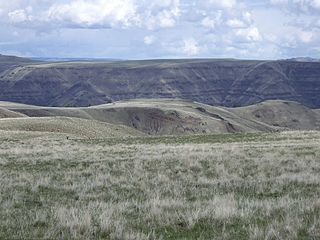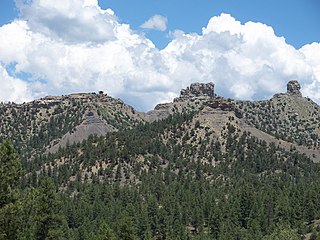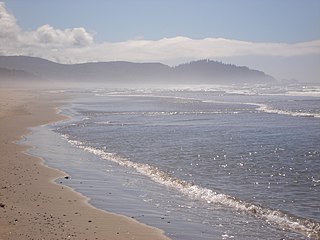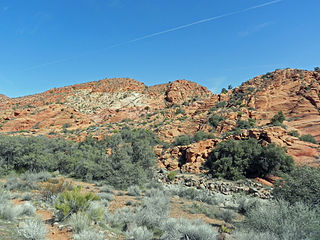Related Research Articles

The peregrine falcon, also known as the peregrine, and historically as the duck hawk in North America, is a widespread bird of prey (raptor) in the family Falconidae. A large, crow-sized falcon, it has a blue-grey back, barred white underparts, and a black head. The peregrine is renowned for its speed, reaching over 320 km/h (200 mph) during its characteristic hunting stoop, making it the fastest bird in the world, as well as the fastest member of the animal kingdom. According to a National Geographic TV program, the highest measured speed of a peregrine falcon is 389 km/h (242 mph). As is typical for bird-eating raptors, peregrine falcons are sexually dimorphic, with females being considerably larger than males. According to one study, it has the fastest visual processing speed of any animal tested so far, and can register discrete changes up to 129 Hz or cycles per second. Analogically, film is a series of still images projected onto a screen. Those still images need to be changing at roughly 24 frames per second before humans see them as fluid and no longer as individual, discrete pictures. The film would have to be refreshing at 129 frames per second before peregrine falcons stopped seeing flashing, still images and started seeing fluid motion.

Forest Park is a public municipal park in the Tualatin Mountains west of downtown Portland, Oregon, United States. Stretching for more than 8 miles (13 km) on hillsides overlooking the Willamette River, it is one of the country's largest urban forest reserves. The park, a major component of a regional system of parks and trails, covers more than 5,100 acres (2,064 ha) of mostly second-growth forest with a few patches of old growth. About 70 miles (110 km) of recreational trails, including the Wildwood Trail segment of the city's 40-Mile Loop system, crisscross the park.

The prairie falcon is a medium-large sized falcon of western North America. It is about the size of a peregrine falcon or a crow, with an average length of 40 cm (16 in), wingspan of approximately 1 meter (40 in), and average weight of 720 g (1.6 lb). As in all falcons, females are noticeably bigger than males. Though a separate species from the peregrine, the prairie falcon is basically an arid environment adaptation of the early peregrine falcon lineage, able to subsist on less food than the peregrine, and generally lighter in weight than a peregrine of similar wing span. Having evolved in a harsh desert environment with low prey density, the prairie falcon has developed into an aggressive and opportunistic hunter of a wide range of both mammal and bird prey. It will regularly take prey from the size of sparrows to approximately its own weight, and occasionally much larger. It is the only larger falcon native only to North America. It is resident from southern Canada, through western United States, and into northern Mexico. The prairie falcon is popular as a falconry bird, where with proper training it is regarded as being as effective as the more well known peregrine falcon.

Arapaho National Forest is a National Forest located in north-central Colorado, United States. The facility is managed jointly with the Roosevelt National Forest and the Pawnee National Grassland from the United States Forest Service office in Fort Collins, Colorado. It has a wildlife refuge which manages a protection for all birds and mammals. The combined facility of 1,730,603 acres is denoted as ARP by the Forest Service. Separately, Arapaho National Forest consists of 723,744 acres.

Zumwalt Prairie is a grassland area located in Wallowa County in northeast Oregon, United States. Measuring 330,000 acres (130,000 ha), much of the land is used for agriculture, with some portions protected as the Zumwalt Prairie Preserve owned by The Nature Conservancy. Part of that portion is designated as a National Natural Landmark. The high altitude prairie is along the west edge of Hells Canyon on the Oregon-Idaho border.

Chimney Rock National Monument is a 4,726-acre (1,913 ha) U.S. National Monument in San Juan National Forest in southwestern Colorado which includes an archaeological site. This area is located in Archuleta County, Colorado, between Durango and Pagosa Springs, and is managed for archaeological protection, public interpretation, and education. The Chimney Rock Archaeological Site has been listed on the National Register of Historic Places since 1970. U.S. President Barack Obama created Chimney Rock National Monument by proclamation on September 21, 2012 under authority of the Antiquities Act.

Chimney Rock is an unincorporated community and USPS in Archuleta County, Colorado, United States. The Chimney Rock Post Office has the ZIP Code 81127. The community was the setting of Marcy Cottrell Houle's book, Wings for My Flight.

Cape Meares National Wildlife Refuge is a National Wildlife Refuge of the Oregon Coast. It is one of six National Wildlife Refuges in the Oregon Coast National Wildlife Refuge Complex. Located on Cape Meares, the refuge was established in 1938 to protect a remnant of coastal old-growth forest and the surrounding habitat used by breeding seabirds. The area provides a home for a threatened bird species, the marbled murrelets. Peregrine falcons, once at the brink of extinction, have nested here since 1987. The refuge, with the exception of the Oregon Coast Trail, was designated a Research Natural Area in 1987.

Eagle Cap Wilderness is a wilderness area located in the Wallowa Mountains of northeastern Oregon, within the Wallowa–Whitman National Forest. The wilderness was established in 1940. In 1964, it was included in the National Wilderness Preservation System. A boundary revision in 1972 added 73,000 acres (30,000 ha) and the Wilderness Act of 1984 added 66,100 acres (26,700 ha) resulting in a current total of 361,446 acres, making Eagle Cap by far Oregon's largest wilderness area.

Bridge Creek Wilderness is a wilderness area located in the Ochoco Mountains of central Oregon, within the Ochoco National Forest. It was established in 1984 and comprises 5,400 acres (2,185 ha), making it one of the smallest Wilderness areas in the state.

Mill Creek Wilderness is a wilderness area located in the Ochoco National Forest of central Oregon. It was established in 1984 and comprises 17,400 acres (7,040 ha). Of the three wilderness areas in the Ochoco National Forest - Mill Creek, Bridge Creek, and Black Canyon - Mill Creek is the largest and most heavily used.

Balch Creek is a 3.5-mile (5.6 km) tributary of the Willamette River in the U.S. state of Oregon. Beginning at the crest of the Tualatin Mountains, the creek flows generally east down a canyon along Northwest Cornell Road in unincorporated Multnomah County and through the Macleay Park section of Forest Park, a large municipal park in Portland. At the lower end of the park, the stream enters a pipe and remains underground until reaching the river. Danford Balch, after whom the creek is named, settled a land claim along the creek in the mid-19th century. After murdering his son-in-law, he became the first person legally hanged in Oregon.

The Columbian sharp-tailed grouse is a subspecies of sharp-tailed grouse native to the Western United States and British Columbia.

Cottonwood Canyon Wilderness is a 11,712-acre (47.4 km2) wilderness area in the US state of Utah. It was designated March 30, 2009, as part of the Omnibus Public Land Management Act of 2009. Located adjacent to the southern edge of the Dixie National Forest, it encompasses and protects a transition zone between the Colorado Plateau to the east and the Mojave Desert to the west. It is bordered by the Cottonwood Forest Wilderness to the northeast and is itself a part of the Red Cliffs National Conservation Area.

The Imperial National Wildlife Refuge protects wildlife habitat along 30 miles (50 km) of the lower Colorado River in Arizona and California, including the last un-channeled section before the river enters Mexico. The Imperial Refuge Wilderness, a federally designated, 15,056-acre (60.93 km2), wilderness area is protected within the refuge. It also surrounds the Picacho State Recreation Area. This section of the Colorado River is popular for boating, hiking, fishing, camping, exploring old mining camps and wildlife watching.

The ecology of the Rocky Mountains is diverse due to the effects of a variety of environmental factors. The Rocky Mountains are the major mountain range in western North America, running from the far north of British Columbia in Canada to New Mexico in the southwestern United States, climbing from the Great Plains at or below 1,800 feet (550 m) to peaks of over 14,000 feet (4,300 m). Temperature and rainfall varies greatly also and thus the Rockies are home to a mixture of habitats including the alpine, subalpine and boreal habitats of the Northern Rocky Mountains in British Columbia and Alberta, the coniferous forests of Montana and Idaho, the wetlands and prairie where the Rockies meet the plains, a different mix of conifers on the Yellowstone Plateau in Wyoming and in the high Rockies of Colorado and New Mexico, and finally the alpine tundra of the highest elevations.

Wings for My Flight: The Peregrine Falcons of Chimney Rock is a 1991 book by American wildlife biologist Marcy Cottrell Houle. Wings for My Flight documents Houle's observations of a pair of the then-endangered peregrine falcons at Chimney Rock, a prominent rock formation in Colorado, while employed by the Colorado Division of Wildlife in the summer of 1975. To protect the falcons, Houle had to halt a million-dollar project to turn ancient Anasazi ruins in the area into a tourist attraction and faced opposition and harassment by the Chimney Rock community as a result.

Vaux's swift is a small swift native to North America and northern South America. It was named for the American scientist William Sansom Vaux.

The Prairie Keepers: Secrets of the Zumwalt is a 1995 book by American wildlife biologist Marcy Cottrell Houle. The book documents Houle's experience studying the unusually prevalent amount of raptors on the Zumwalt Prairie while researching for Oregon State University with a grant from the U.S. Fish and Wildlife Service in 1979.
References
- 1 2 3 4 5 6 7 8 9 Schoolman, Ethan (2009). Cevasco, George A.; Richard P. Harmond (eds.). Houle, Marcy Cottrell. Modern American Environmentalists: A Biographical Encyclopedia. Johns Hopkins University Press. pp. 206–211.
- ↑ "Faculty". University of Oregon. Archived from the original on June 26, 2012. Retrieved April 30, 2018.
- 1 2 3 Houle, Marcy Cottrell (2010). One City's Wilderness: Portland's Forest Park (3rd ed.). Corvallis, Oregon: Oregon State University Press. ISBN 978-0-87071-588-4. LCCN 2010007205. OCLC 544474594.
- ↑ "The Prairie Keepers: Secrets of the Zumwalt". Oregon State University Press. Retrieved November 13, 2014.
- ↑ Houle, Marcy Cottrell. "Op-Ed How our healthcare system can be deadly to the elderly". Los Angeles Times. Retrieved 18 October 2015.